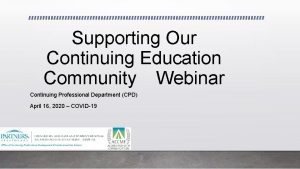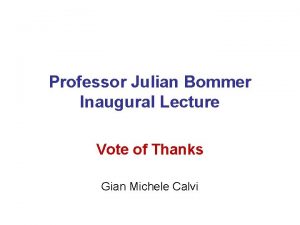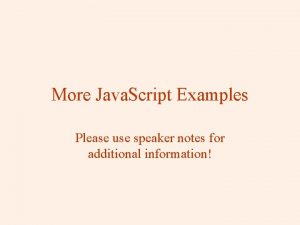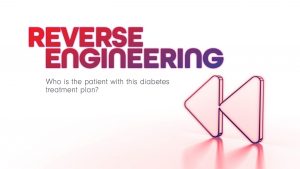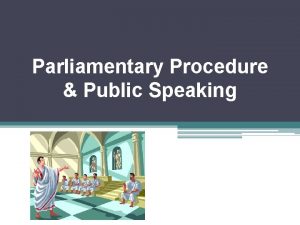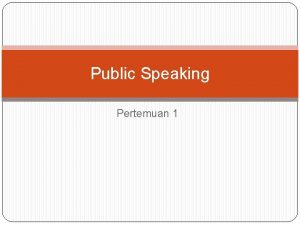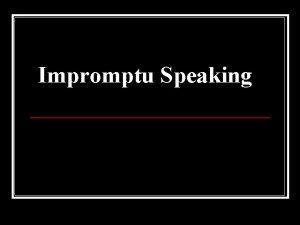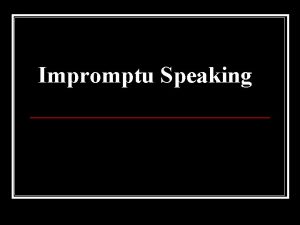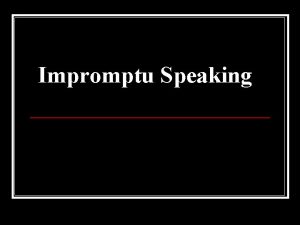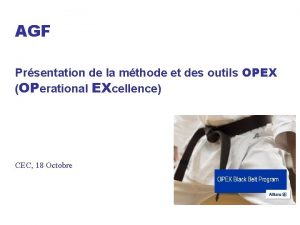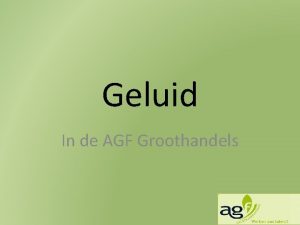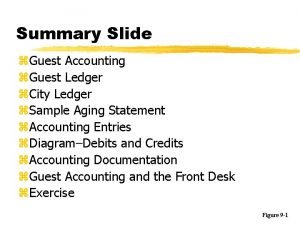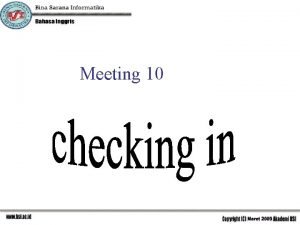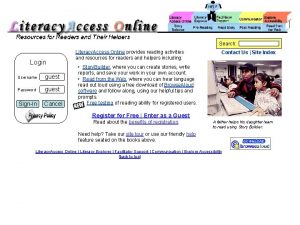SPEAKING NOTES FOR THE AGF AS GUEST SPEAKER



























- Slides: 27

SPEAKING NOTES FOR THE AGF AS GUEST SPEAKER AT THE FEBRUARY, 2020 EDITION OF THE BPSR LUNCH TIME REFORM SEMINAR SERIES HOLDING ON 4 TH FEBRUARY, 2020 WITH THE TOPIC “TRANSFORMATION AND DIGITALIZATION OF PUBLIC FINANCIAL MANAGEMENT SYSTEM IN NIGERIA: INNOVATIONS, BOTTLENECKS AND WAY FORWARD”

INTRODUCTION q I thank the BPSR for inviting me. The lunch time reform seminar series is, indeed, an important innovation. The BPSR, as chief Articulator and Driver of the Public Sector Reform policy, has done very well and will certainly continue to soar under its present leadership. For us in the Treasury, the topic of public sector financial management reform will always continue to excite us. q I will surely not want to bore you with the history of Nigeria’s Public Service Reform; suffice to state that the National Strategy for Public Service Reform (NSPSR) provides a common vision and it is, indeed, the special purpose vehicle (SPV) for Nigeria to achieve a world class public service by this year (2020). q The public financial management reform is PILLAR THREE of the NSPSR. 2

q The core objective of the Pillar Three is to ensure professionalism, transparency, efficiency, accountability and probity in financial management. q A number of reform strategies aimed at enhanced economic coordination with a view to achieving and sustaining the NSPSR philosophy will be discussed in due course. 3

PUBLIC SECTOR FINANCIAL MANAGEMENT SYSTEM IN NIGERIA – YESTERDAY IN PERSPECTIVE v Prior to the PFM reforms in Nigeria the following realities were common characteristics of our situation: Ø Over dependence on oil Ø Low human development index Ø Volatile and uncontrolled fiscal management Ø Decayed infrastructure Ø High rate of crime and corruption Ø Over bloated public service Ø Ghost Worker syndrome 4

There was also general inefficiency in the values-delivery processes. Low IT knowledge /infrastructure, low capacity and capability of personnel. Inaccurate and incomplete data. Late consolidation and reporting of government financial position. Disjointed planning etc. It was obvious that the legacy systems could not endure. Something, indeed has to change. Inevitably !!! 5

PUBLIC FINANCIAL MANAGEMENT SYSTEM IN NIGERIA – INNOVATION AND CURRENT TRENDS q To address the shortcomings of yesterday, a number of reform processes were initiated and are presently being deepened. Ø E-payment System: ü Automated processing of transactions ü Faster and swifter ü Business/commerce facilitation ü Reduced corruption ü Reduced paper work ü Enhanced tracking 6

Ø IPPIS ü Unique FGN system that covers the feature of PERSONNEL and PAYROLL management electronically. ü Centralized record ü Ascertaining actual personnel ü Data base integrity ü Eliminates payroll fraud ü Effective budgeting ü Aids cash management ü Comprehensive personnel record and history ü Easy retrieval of record.

Ø GIFMIS ü IT based ü Supports public resource management ü Comprehensive accounting/payment platform ü Modern fiscal management tool ü Budget Preparation, Execution and Reporting ü Addresses critical public financial management weaknesses ü Aids FGN ability to take central control and monitoring of receipts and expenditure ü Visibility of government financial transactions 8

Ø TSA ü Reformed government banking arrangement ü Address weaknesses of government cash management ü Ensure efficient control and monitoring of funds, and allows for fungibility of cash resources ü Improved liquidity of government ü Visibility of cash resources by MDA. ü Block leakages in revenue generation collection and remittance. ü Categorizes funds and their sources. 9

Ø CASH MANAGEMENT ü Cash is always scare ü A strategy for managing cash is therefore necessary ü Cash inflows and outflows should properly planned and monitored and evaluated ü Discretionary spending should be avoided to minimise deficit and stray within borrowing limit ü The TSA regime has enhanced our cash flow ü Once our GIFMIS Cash Management functionality is fully activated a bottom-up Cash Management approach will be enshrined ü A new Cash Management Policy Guidelines has been approved by the FEC ü The Governance structure for Cash Management Federal Cash Management 10

Ø ASSET TRACKING AND MANAGEMENT ü In compliance with IPSAS requirement Assets should be properly reconginsed ü A database of Federal Government Asset is very critical ü All Federal Government MDAs/entities must maintained an asset register ü Valuation of Asset must be Professionally undertaken ü Public properties must be protected from leverage and loss. ü The Asset Tracking Management is therefore a necessary project for coordination and guidance in achieving the above. ü Disposal of Asset are also to be monitored under these arrangement. 11

Ø IPSAS ü In July 2010 the Federal Executive Council approved the adoption of IPSAS ü A road map committee was set up by FAAC in June 2011 ü The IPSAS are meant to improve the quality of General Purpose financial reporting ü Greater disclosure ü The standards are also meant to enhance the quality and transparency of public financial reporting ü International convergence and best practice ü A lot of progress has been made from adoption to cash basis and to accrual basis implementation . 12

Ø FINANCIAL TRANSPARENCY POLICY/OPEN TREASURY PORTAL ü A perhaps the most recent reform initiative of the FG ü Launched on 9 th December, 2019 ü Require publication of financial information through the Open Treasury Portal ü Expenditure of N 5 m and above to be published by all MDAs ü Monthly budget performance of MDAs to be published ü Fiscal Performance of the FG to be published monthly ü Quarterly financial statements to be published ü Annual General purpose Financial Statement to be published ü Policy aimed at promoting principles of accountability and transparency in FPM system. 13

Ø MODERNISATION OF INTERNAL AUDIT ü Of strategic importance to public financial management and control is a robust and effective internal control mediansion ü A good internal control framework improves by ensuring compliance to laid down rules, regulations and procedures ü Under the Internal Audit reform, numerous Internal Auditors were trained in Risk- Based Audit. New audit methodologies and audit manual were issued. ü Auditing in IT environment, compliance audit, value for money audit, performance audit, auditing Avoidance are some of the focal area receiving attention 14

Ø THE FTA OROZO ü Treasury Academy ü The World Bank supported the restructuring of the FTA ü Twining arrangement with between the FTA and CIFA and ICAN ü Collaboration with NOUN to set up a Business School at the FTA ü Facilities intended to be modeled to provide training and qualification on PFM (i. e professionlising PFM) 15

LEVERAGING ON IT AND OTHER DIGITAL ENABLERS v Digitization of the PFM Reforms ü Infrastructure is integral ü Accessibility through unique password given to Users ü Interactive software ü Integrated system ü Audit trail ü Reportability ü Clear classification of transactions v Interface and handshakes with all subsystems v Digitalization enhances openness and transparency 16

v Current IT infrastructure driving the reform v The GIFMIS/IPPIS systems are critical national IT assets ü A certification to this fact has been issued by the ONSA IT security and risk management v ü Measures have been taken to secure the platforms and the overall infrastructure v Attempted violations and infractious are investigated and dealt with v Staff capacity and IT knowledge ü This is a critical success factor ü Over the years, especially in the last 5 years, the IT knowledge, capacity and ability of the Treasury Staff has improved tremendously. This has helped THE OUTCOMES OF THE PFM reforms. More efforts are being made to upgrade the IT infrastructure. Ditto training and retraining

BOTTLENECKS Inadequacies of infrastructure Resistance/Change Management issues Integration with relevant Agencies Covering the Legislature and Judiciary Risk of identity theft System failures Funding challenges Capacity building Reward and incentives Covering sub-nations (States and LGs) Manpower sustainability 18

THE WAY FORWARD q Improved infrastructure q Sensitization q Training and retraining q Sustained political will q Convergence with international standards q Enhanced cyber security q Manpower sustainability q Documentation and issuance of process manuals q Advocacy q Full coverage to all arms of government and sub-nationals q PFM systems to be part of the curriculum in universities and other tertiary institutions q Collaboration between public sector and private sector q Monitoring and evaluation. 19

A. WHY DO WE NEED REFORMS? 1) Departure from old practices and ways of doing things 2) Dynamism of life necessitates changes and reforms 3) To conform to international best practices 4) To bring about efficiency and effectiveness in service delivery 5) To meet the ever-increasing expectations of the citizens 20

A. WHY DO WE NEED REFORMS CONT’D? 6) Deliver dividends of democracy 7) To entrench the culture of transparency. Probity and accountability 8) To fight corruption 9) To stimulate economic growth and development 10) To build trust and generate confidence of the people in government 11) To manage our lean resources efficiently 12) To harness vast human and material resources and potentials that abound in this country. 21

B. PRE-REQUISITES FOR REFORMS 1) Right and honest leadership 2) Political Will 3) Accepting change 4) Balancing between politics and the real needs of the people 5) Training and capacity building 6) Education, sensitization and awareness creation 7) Coordination and synergy between institutions responsible for implementing reforms 8) Effective peer review mechanism among agencies and institutions. 22

C. BOTTLENECKS 1) Resistance to change 2) Poor sensitization 3) Lack of capacity and training 4) Inadequate funding 5) Low level synergy and coordination 6) Policy sommersault 7) Lack of legislation to back reforms 23

D. SUSTAINABILITY OF ALL REFORMS Public Finance Reforms initiatives should be supported, sustained and protected. We have already worked out a draft legislations for the attention and approval of Federal Executive Council (FEC) to give legal framework to the various public finance reforms being implemented by the Office of the Accountant -General of the Federation. These draft legislations are as follows: Public Finance Mgt Bill, 2020 (repealing the Finance Control Mgt Act, 1958) Federal Treasury Academy Orozo and Related Matters Bill, 2020. We should not leave reforms to the whims and caprices of politicians. Effective monitoring and evaluation. 24

SUSTAINABILITY OF ALL REFORMS CONT’D Since the emergence of the present administration of President Muhammadu Buhari, we have seen a renewed commitment and political will as well as matching directive to support the various public reforms in this country, including these proposed legislation. 25

CONCLUSION q A well functioning PFM systems are necessary tools for efficient and effective management of public finance q A good and well implemented PFM reform will lead to fiscal discipline and, invariably, well horned service delivery. q Digitalization leads to accountability q The PFM systems should ultimately be owned by the public through robust interactive digital channels that provide opportunity for agenda-setting and feed back. q Innovation should continue with a view to consolidate current gains and advance to the future with greater efficiency. q Ultimately, transparency will be the pull towards public trust which is critical to good governance. 26

THANK YOU FOR LISTENING 27
 Shema sic
Shema sic Welcome address for webinar sample
Welcome address for webinar sample Julian bommer
Julian bommer Speaker notes examples
Speaker notes examples What are speaker notes in a powerpoint
What are speaker notes in a powerpoint Wisc
Wisc Densitet vatten
Densitet vatten Elektronik för barn
Elektronik för barn Borra hål för knoppar
Borra hål för knoppar Tack för att ni har lyssnat
Tack för att ni har lyssnat Sura för anatom
Sura för anatom Smärtskolan kunskap för livet
Smärtskolan kunskap för livet Bris för vuxna
Bris för vuxna Argument för teckenspråk som minoritetsspråk
Argument för teckenspråk som minoritetsspråk Novell typiska drag
Novell typiska drag Trög för kemist
Trög för kemist Autokratiskt ledarskap
Autokratiskt ledarskap Humanitr
Humanitr Vilka tal pekar pilarna på
Vilka tal pekar pilarna på Blomman för dagen drog
Blomman för dagen drog Redogör för vad psykologi är
Redogör för vad psykologi är En lathund för arbete med kontinuitetshantering
En lathund för arbete med kontinuitetshantering Mat för unga idrottare
Mat för unga idrottare Skapa med geometriska former
Skapa med geometriska former Etik och ledarskap etisk kod för chefer
Etik och ledarskap etisk kod för chefer Offentlig förvaltning
Offentlig förvaltning Fredsgudinna pax
Fredsgudinna pax Datorkunskap för nybörjare
Datorkunskap för nybörjare

